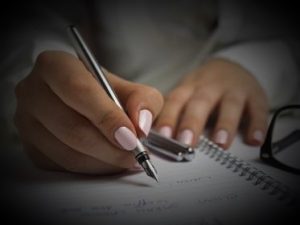Tapping Into The Creative Process…Part II
Lynne Calaway
Prose with poetic flair float slowly before your eyes —distinct, and succinct and almost touchable before evaporating in thin air. Waves of rhythmic beats flood your senses with notes of tracks you’ve yet to write then, suddenly, fade into silence. Do you wait…confidently believing that, like homemade soup simmering on low—when a piece is ready, it’s ready—or dive right in with a laptop or keyboard to see what happens and lay groundwork for what can? Are you someone who shares your work as you go or only after it’s finished, and what needs to happen for you to decide it is, indeed, finished? Do you take an original inspiration and polish it up or regard it simply as a source of usable parts? Our creative process encompasses many considerations, evolves over time and is as unique and individualized as we are, not matter who we are…
Miles Davis, musician, “Venus de Milo” & “A Kind of Blue”, revealed that he wrote just one note at a time and allowed his music to simply “emerge” and when performing, if he played a “bad” note that a “good” note played immediately after would always correct it. Baulking at the label given him of “jazz” musician, he warned musicians that such labels limited what their music could be as well as implied something already existed to which it could be compared. He added that he didn’t “play” music, the notes he played were not the notes that were there but notes that weren’t and that through his constant experimentation with, and manipulation of, those notes he “created” music and a musical style that was indefinable.
Ed Sheeran, musician, whose hits include “Eyes Closed” & “Perfect”, often shares that he ascribes to the 10,000 Hour Rule (a concept formulated by Malcom Gladwell, Canadian journalist and author): that it takes at least 10,000 hours of practice to achieve “expertise”. He, therefore, stresses the importance of writing every day and that you should anticipate—even embrace—that you’ll write [crappy] songs in the beginning and feels it’s imperative to get “bad” ones out of your system to make way for the good ones. Ed uses the analogy of a running faucet: in the beginning it flows with dirty water but allowed to run long enough, it reaches a point where the water [the creative work] is clear.
Pearl Cleage, playwright, novelist & poet, “Things I should have Told My Daughter: Lies, Lessons & Love Affairs” & “Other Reasons to Riot” first starts her novels in long hand on a yellow legal pad. Highly disciplined, she likes to start promptly at 11 a.m., and always listens to music but only music she’s familiar with so as not to become distracted by focusing on the new sounds. She admits to using very long sentences when writing her novels (joking that unlike with her Tony Award-winning plays, live actors need time to catch their breath) and believes that one can write an entire paragraph, even a chapter, in one long sentence if you are diligent about your punctuation. Pearl reads everything she writes aloud requiring that her works always have a rhythmic beat.
Danielle Steel, romance novelist, Flying Angels, revealed that her books are about things that “hurt or scare us” and that her inspirations simply fall “out of the sky”, i.e., a newspaper article or having heard of someone’s personal experience. She says she then writes a ton of notes and begins “getting to know” the characters, which can be a six-month process itself before she even gets to the plot and admits to writing approximately 20 hours a day. Danielle says she never writes to please but only to get the stories out of her head and admits she still composes her novels on the $20.00 junk-store typewriter purchased while in college because its slowness allows her time to better process each word.
Former Beatle, Paul McCartney, whose songs included “She Loves Me” and “Yesterday”, admits to starting songs with little more than a note and that his creative “method” is not having a method. He reveals that he first connects with a musical key first, then an idea, then maybe the first verse to see where that leads him. He develops a “skeleton”, then allows the melody and lyrics to manifest as he goes, stating that revisions are a rarity. He has shared that the Beatles’ groundbreaking hit, “She Loves You”, was written in only 3 hours. Paul said he’d often write entire songs in his head and, when questioned about his fear of forgetting the lyrics, would respond that if he couldn’t remember the song, neither would the audience.
